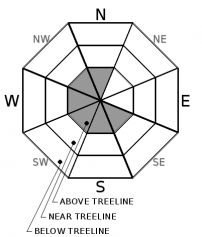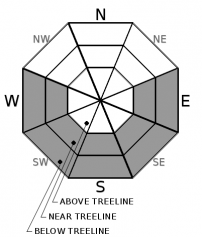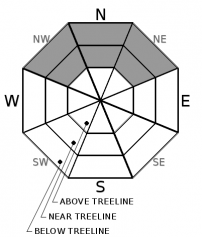| Sunday | Sunday Night | Monday | |
|---|---|---|---|
| Weather: | Sunny then becoming partly cloudy. Chance of snow in the afternoon. Snow levels below 7000 feet. Chance of precipitation is 25%. | Mostly cloudy then becoming partly cloudy. Chance of snow. Snow levels below 7000 feet. Chance of precipitation is 25%. | Mostly cloudy. Snow likely. Snow levels below 7000 feet. Chance of precipitation is 55%. |
| Temperatures: | 38 to 43 deg. F. | 22 to 27 deg. F. | 34 to 40 deg. F. |
| Mid Slope Winds: | Light winds. | Light winds. | Light winds becoming southwest 15 to 25 mph with gusts to 45 mph in the afternoon. |
| Expected snowfall: | Up to 1 inch. | SWE = less than 0.10 inch. | 80% probability up to 1 inch. 20% probability of 1 to 2 inches. | SWE = less than 0.10 inch. | 80% probability up to 2 inches. 20% probability of 2 to 4 inches. | SWE = up to 0.15 inch. |
| Sunday | Sunday Night | Monday | |
|---|---|---|---|
| Weather: | Sunny then becoming partly cloudy. Chance of snow in the afternoon. Snow levels below 7000 feet. Chance of precipitation is 30%. | Mostly cloudy then becoming partly cloudy. Chance of snow. Snow levels below 7000 feet. Chance of precipitation is 30%. | Mostly cloudy. Snow likely. Snow levels below 7000 feet. Chance of precipitation is 55%. |
| Temperatures: | 30 to 36 deg. F. | 19 to 24 deg. F. | 29 to 35 deg. F. |
| Ridge Top Winds: | Southeast around 15 mph with gusts to 25 mph. | Light winds becoming southwest around 15 mph with gusts to 25 mph after midnight. | West 15 to 20 mph with gusts to 40 mph shifting to the southwest 20 to 30 mph with gusts to 60 mph in the afternoon. |
| Expected snowfall: | Up to 2 inches. | SWE = less than 0.10 inch. | 80% probability up to 1 inch. 20% probability of 1 to 2 inches. | SWE = less than 0.10 inch. | 80% probability of 1 to 2 inches. 20% probability of 2 to 4 inches. | SWE = up to 0.15 inch. |






















